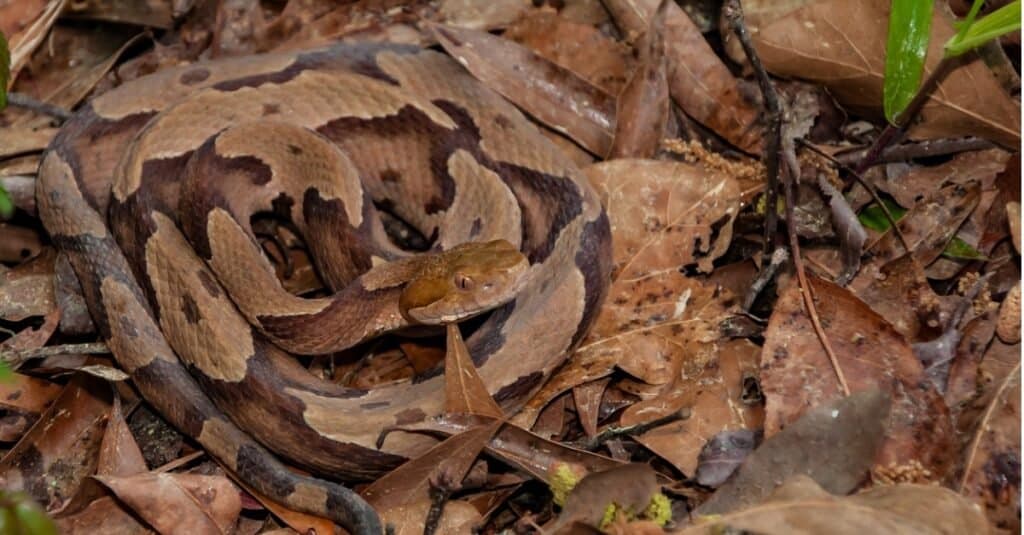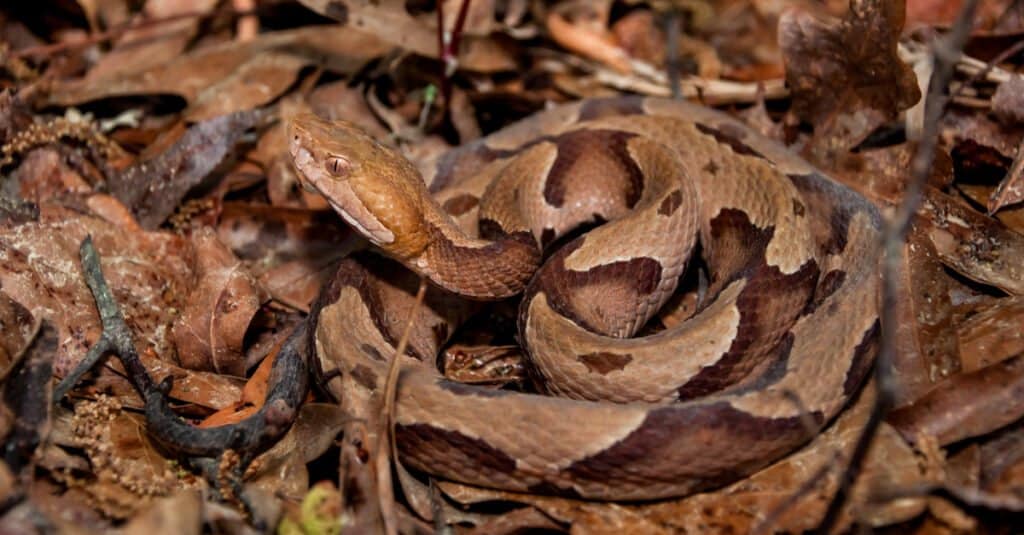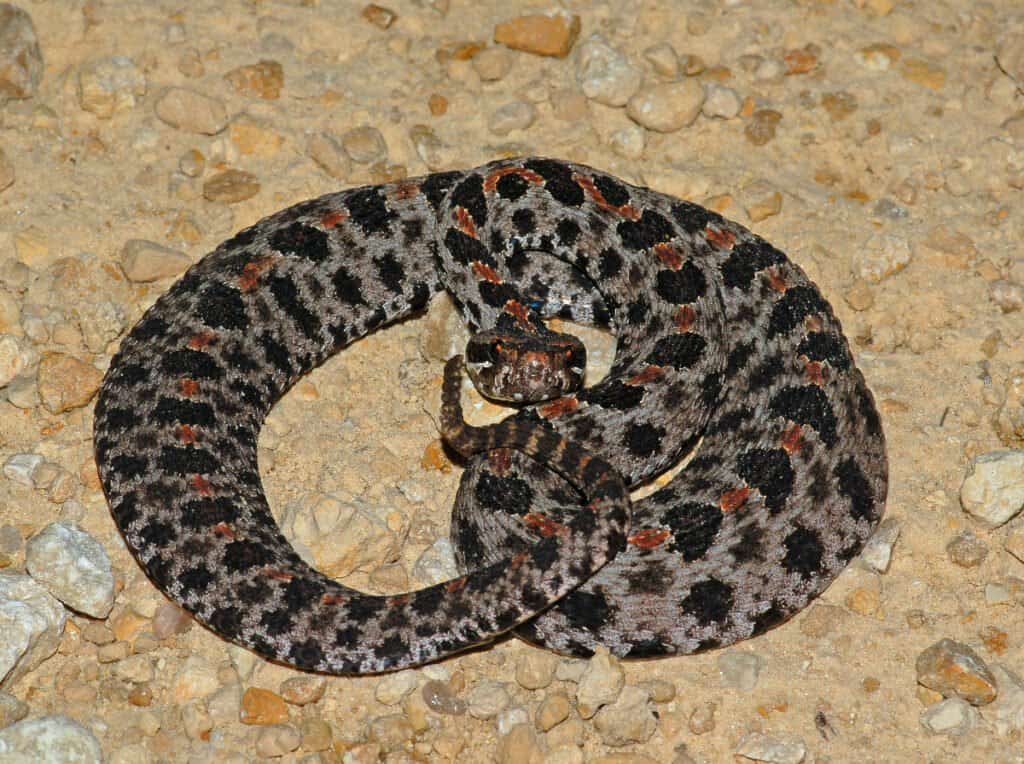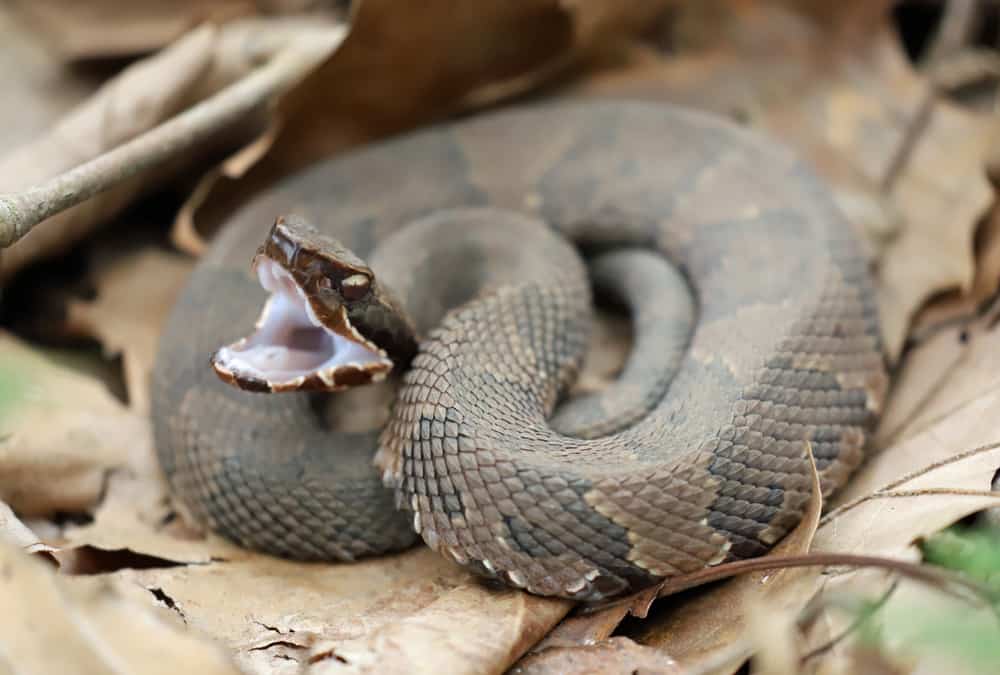Key Points:
- North Carolina has one subspecies of copperhead — the eastern copperhead — and it lives all over the state, generally found in deciduous forests and mixed woodland habitats.
- One of their intimidating and distinguishing features is a pair of bright yellow, cat-like eyes with slanted pupils and a stern-looking brow.
- Accounting for 10 times more bites than all other snakes combined, copperheads are the most common venomous snakes in North Carolina. A copperhead bite requires immediate medical attention and fatality is possible but rare.
Copperheads are some of the most common snakes in the southeast. Their camouflage makes them incredibly hard to see until it’s too late, and with how common they are and how well they can hide, it’s no surprise that they are responsible for the most bites of any venomous snake in the southeast. North Carolina is home to a few venomous snakes, but is the copperhead among them? Let’s learn about these reptiles and see how dangerous they are.
Do Copperheads Live in North Carolina?

Copperheads live across every region of North Carolina.
©iStock.com/JasonOndreicka
Copperheads live in North Carolina and can be found almost everywhere across the state.
There are a few subspecies of copperhead that live in the United States, and North Carolina is home to one of them. The subspecies native to North Carolina is the eastern copperhead, which is the most widespread copperhead subspecies of all. Historically, the eastern copperhead was broken into three subspecies, the northern, southern, and Osage copperhead. DNA evidence has since shown them to be too similar to be broken into different subspecies. As such, North Carolina is now only home to one recognized subspecies of the copperhead.
Identifying a Copperhead
Copperheads are copper in color, although the shading can occasionally vary. They can be dark copper, reddish copper, and even a pinkish color in some individuals. They have a distinctive banding pattern down their bodies that resembles an hourglass. The thinnest portion of the hourglass is usually across the spine, while the thicker “reservoir” of the hourglass is along each of the sides of the snake. These hourglass patterns repeat from behind the head and down to the tail.
The eyes of a copperhead are usually bright yellow and closely resemble that of a cat eye. Their pupils are slits, and they have a characteristic brow scale that juts out over the eye. The slanted pupil and eyebrow scales give copperheads a distinctive “mean” look that is easily recognizable.
Additionally, copperheads belong to a group of snakes known as pit vipers. Pit vipers have small, heat-sensing pits near their snout between their eyes and nose on both sides. As copperheads are pit vipers, they have these distinctive pits that clearly differentiate them from any other non-venomous snake that could potentially look similar.
Where Do Copperheads Live?

Copperheads can be found in all three regions of North Carolina.
©iStock.com/David Kenny
Copperheads are the most widespread venomous snake across the entire state. You can split North Carolina into three segments, the mountains in the west, the central Piedmont, and the eastern coastal plain. Despite these regions having vastly different ecosystems and habitats, copperheads can be found in all three.
Copperheads live across the entire state, even across the Outer Banks region.
What Kind of Habitat Do Copperheads Prefer?
Copperheads are generalists that can be found all across the state, but they do have a preferred habitat where they are more likely to be found. Across most of the U.S., copperheads are most likely to be found in deciduous forests and mixed woodland habitats. Although it isn’t as common, they are also found near swamps and wetlands, but they generally leave those regions to the cottonmouths.
The different species live in different habitats, with an example being the broadband copperhead living in proximity to arid and desert regions.
During the winter, copperheads brumate (hibernating for reptiles) with black rat snakes and timber rattlesnakes. They will generally find dens in limestone crevasses or underground and try to keep warm for the winter. In North Carolina, copperheads are most active from April to September.
How Dangerous Are Copperheads?

Copperhead bites are painful but rarely deadly to most people.
©Jay Ondreicka/Shutterstock.com
Copperheads are a member of the pit viper family, meaning they are quite venomous. Thankfully, they aren’t as dangerous as other members of the Viper family are. When compared to other pit vipers, they have the lowest potency, with the cottonmouth being slightly more potent.
Additionally, copperheads don’t prefer to bite and would much prefer to stay hidden and camouflaged. When they do bite, it’s also pretty common for them to “dry bite” as a warning of potential threats.
When a copperhead does bite and inject venom, however, it is still wise to treat it as an emergency. Common symptoms include pain, tingling, throbbing, swelling, and severe nausea. Symptoms will occur immediately, and medical attention is necessary with any bite from a venomous snake.
Thankfully, fatalities are extremely rare with copperhead bites, especially when medical professionals are able to administer antivenom within a short time after the initial bite.
How Often Are People Bitten by Copperheads?

Copperhead bites are more common than other venomous snake bites.
©Jeff W. Jarrett/Shutterstock.com
Copperhead bites are the most common venomous snake bites of any snake in the state by far.
In fact, copperhead bites are so much more common than other venomous snake bites. The NC Poison Control statement on the matter says: “It is the most common poisonous snake in North Carolina. The poison center receives 10 times the number of calls about copperhead bites than all other snakes combined. The good news is that about half of copperhead snake bites result in only mild swelling and pain.”
Although the potential for death is present, this is usually only the case with extremely vulnerable individuals (sick and elderly) or those with undiagnosed allergic reactions to snake venom.
This trend tracks when you zoom out on the United States as a whole. Copperheads bite more people than all other snakes in America. This is most likely because of how discreetly they can camouflage themselves.
When people can’t tell that a snake is on the ground in front of them, it’s easy to accidentally step on the hidden snake. Then, a bite is almost inevitable, so you better hope you’re wearing shoes and/or clothes that protect you from those fangs.
How Do You Keep Copperheads Out of Your Yard?

Is a copperhead lurking in your yard? Regular upkeep, including clearing away areas where snakes could hide, can help prevent copperheads from taking up residence.
©iStock.com/JWJarrett
The last thing a person wants is to encounter a venomous copperhead on their property! If your yard attracts snakes like copperheads, it can be a serious problem.
Snakes are attracted by rodents like rats, moles, and mice, which they prey on. Keeping the rodent population in your yard and around your house under control by using traps or other rodent-repelling solutions will help send copperheads searching elsewhere for their next meal.
Wood piles, loose debris, overgrown grasses and vegetation, and unpruned bushes can attract snakes, so it’s important to maintain your yard, elevate wood piles if possible, and clear away anything that may provide a hiding place for a reptile.
When working in your yard, you should consider wearing boots, long pants, and thick gardening gloves if you’re working in areas where you think snakes might lurk. That way, if you do stumble upon one, you’ll hopefully avoid a poisonous bite.
What Other Venomous Snakes Live in North Carolina?
There are other venomous snakes in the state besides the copperhead.
Timber Rattlesnake

The timber rattlesnake is most common in the mountains and across the coastal plain.
©Frode Jacobsen/Shutterstock.com
Eastern Diamondback

The eastern diamondback is most commonly seen across the southeastern coastal plain.
©Chase D’animulls/Shutterstock.com
Pigmy Rattlesnake

The pigmy rattlesnake is found across the southeastern coastal plain and in pine flatwoods.
©Gerald A. DeBoer/Shutterstock.com
Cottonmouth

The cottonmouth can be found in swamps and wetlands all around North Carolina.
©KF2017/Shutterstock.com
Coral Snake

The eastern coral snake is rare across North Carolina but is highly venomous.
©Patrick K. Campbell/Shutterstock.com
Copperhead Snakes vs. Rattlesnake: Who Would Win?
It is not appropriate to say one would “win” a fight between a copperhead snake and a rattlesnake as both are wild animals and it would be a dangerous encounter for both. They are not naturally inclined to fight each other and would likely avoid each other in the wild.
Additionally, the outcome of a fight between two animals can depend on a variety of factors, such as the size and age of the animals, their physical condition, and the specific circumstances of the encounter. So it is not possible to say who would win in a hypothetical fight between the two animals.
If we have to compare the copperhead snake and rattlesnake, the latter has a more venomous bite. Rattlesnakes are generally considered to be more venomous than copperheads. The venom of a rattlesnake is primarily composed of hemotoxins, which can cause tissue damage and can lead to serious health issues if not treated promptly.
While copperhead venom is also dangerous, it is not as toxic as that of a rattlesnake. The venom of a copperhead is primarily composed of neurotoxins, which affect the nervous system and can lead to pain, swelling, and other symptoms. However, it is important to note that the severity of a snake bite can depend on many factors, such as the size and age of the snake, the location of the bite, and the individual’s response to the venom.
Copperhead Population By State
If you’re interested in where else copperheads can be found apart from North Carolina, we have a helpful breakdown of the copperhead population by U.S. state.
The state with the most number of species of copperheads is Oklahoma. It has four: the eastern copperhead, Osage copperhead, broad-banded copperhead, and southern copperhead.
Following close behind is Alabama, with three species of copperheads: the eastern copperhead, northern copperhead, and southern copperhead.
While copperheads are a common species, they are not found in every state. Alaska, Arizona, California, Colorado, Hawaii, Idaho, Maine, Michigan, Minnesota, Montana, New Hampshire, New Mexico, North Dakota, Rhode Island, South Dakota, Utah, Vermont, Washington, Wisconsin, and Wyoming all have no copperheads.
The photo featured at the top of this post is © iStock.com/Mark Kostich
Discover the "Monster" Snake 5X Bigger than an Anaconda
Every day A-Z Animals sends out some of the most incredible facts in the world from our free newsletter. Want to discover the 10 most beautiful snakes in the world, a "snake island" where you're never more than 3 feet from danger, or a "monster" snake 5X larger than an anaconda? Then sign up right now and you'll start receiving our daily newsletter absolutely free.
Thank you for reading! Have some feedback for us? Contact the AZ Animals editorial team.







